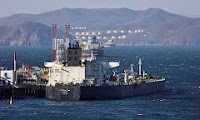Western sanctions on Russia have significantly reduced state
oil revenues and diverted tens of billions of dollars towards shipping and
refining firms, some with Russian connections.
Most of
the winners from the sanctions are based in China, India, Greece and the United
Arab Emirates, a handful are partly owned by Russian companies.
None of the firms is breaching sanctions, but they have
benefited from measures designed by the European Union and the United States to
reduce the revenues of what they call Russian President Vladimir Putin's war
machine.
As the
Ukraine conflict heads into a second year, the calculations show that Russia's
income has dropped but the volume of exports has remained relatively stable
despite sanctions.
Putin
told the West that sanctions would trigger an energy price rally. Instead,
international benchmark Brent oil prices have fallen to US$80 per barrel from a
near-all-time high of US$139 in March 2022, weeks after the start of the war.
Before Moscow's invasion of Ukraine began on February 24 last year, Brent
traded at around US$65 to US$85 per barrel.
After the Group of Seven (G7) industrialized nations imposed
a price cap on Russian oil in December 2022, Moscow's oil export revenues fell
by 40%YoY in January this year, Russia's finance ministry said.
"Low official oil price meant that the Russian state
budget has suffered in recent weeks," Sergey Vakulenko, non-resident
fellow at the Carnegie Endowment for International Peace, said.
Vakulenko was a former head of strategy at Russian energy
major Gazprom Neft. He left the firm and Russia days after the start of the
war.
"Judging
by the customs statistics, some of the benefit was captured by refiners in
India and China, but the main beneficiaries must be oil shippers,
intermediaries and the Russian oil companies," he added.
Sanctions on Russia - probably the harshest imposed on an
individual state - include outright bans on purchases of Russian energy by the
United States and the EU, as well as bans on the shipping of Russian crude
anywhere in the world unless it is sold at or below US$60 per barrel.
Russia has diverted most crude and refined products to Asia
by offering steep discounts to buyers in China and India versus competing
grades from the Middle East, for instance.
The ban on shipping and the price cap have made buyers wary
and forced Russia to pay for transportation of crude as it does not have enough
tankers to carry all of its exports.
As of late January, Russian oil firms were offering
discounts of up to US$20 per barrel for crude to buyers in India and China.
In addition, Russian sellers have also paid up to US$20 per
barrel to shipping companies to take crude from Russia to China or India.
As a result, Russian companies received only less than US50
per barrel of Urals at Russian ports in January, down 42%YoY and just 60% of
the European Brent benchmark price, according to the Russian Finance Ministry.
By
comparison, a US exporter of Mars crude - a grade similar to Urals - would pay
about US$5 to US$7 per barrel for shipping a cargo to India. Given a discount
of US$1.6 per barrel versus the US benchmark WTI, a US exporter would collect
some US$66 per barrel at a US port, or 90% of the benchmark price.
With output of 10.7 million barrels per day (bpd) in 2022
and exports of crude and refined products of 7.0 million bpd, the discount and
additional costs would see Russian producers' revenues falling by tens of
billions of dollars in 2023.
The head of the International Energy Agency (IEA), Fatih
Birol, said on Sunday the price cap reduced Moscow's revenue by $8 billion
in January alone.
However, because some lost revenues are captured by Russian
firms, the exact hit to earnings of producers and the state is difficult to
quantify.
As a further complication, some Russian oil grades,
including Pacific grade ESPO, are also worth more than Urals.






